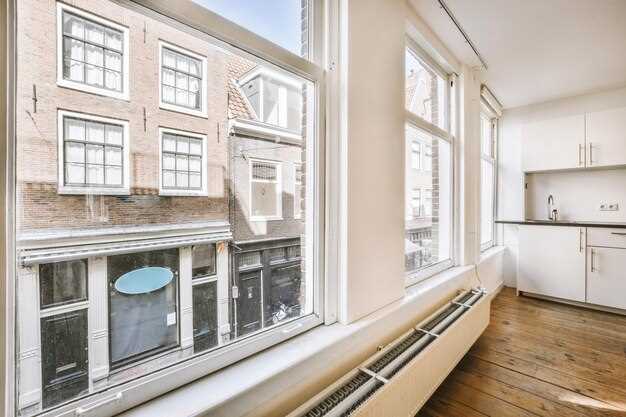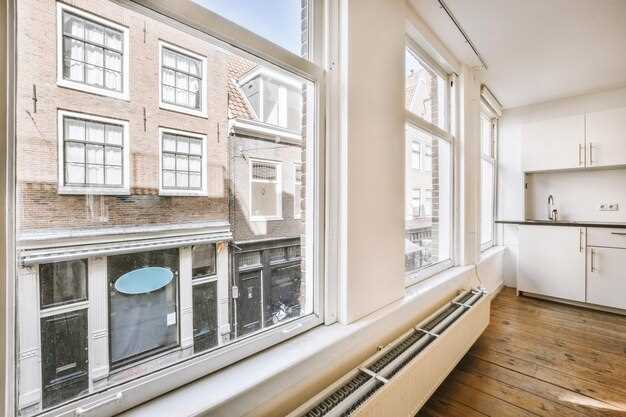Brownstone Renovation Tour – Maximizing Natural Light
May 17, 2025

Choose light-colored window treatments. Heavy curtains and dark shades absorb natural light and can make spaces appear smaller. Opt for translucent blinds or sheer curtains that diffuse sunlight while maintaining privacy. This simple change can dramatically brighten rooms and create a more welcoming atmosphere.
Install mirrors strategically to amplify light. Placing mirrors opposite windows reflects daylight throughout the room, doubling the effect. Consider large wall mirrors or multiple smaller ones grouped together for visual interest and light maximization. Their decorative appeal adds depth and character to your spaces without sacrificing functionality.
Replace solid exterior doors with ones featuring glass panels. Whether choosing partially glazed or full-glass designs, these doors invite more light indoors and enhance the visual connection with the outdoor environment. Even in narrow brownstone entries, the difference will be noticeable, transforming dark hallways into bright, inviting spaces.
Repaint walls and ceilings in light, neutral hues. White or beige paints with a matte or eggshell finish will reflect more light than darker, glossier colors. These shades function as a blank canvas, allowing natural light to bounce freely, illuminating architectural details and enhancing other design elements.
Planning and Design Strategies for Natural Light Enhancement

Consider installing large, strategically placed windows and skylights to flood your spaces with natural light. Prioritize south-facing windows for maximum sunlight exposure throughout the day. Additionally, opt for floor-to-ceiling glass doors that connect interiors with outdoor living areas.
- Utilize reflective surfaces such as mirrors, glass furniture, and glossy finishes to bounce light across rooms, enhancing brightness and creating a more expansive feel.
- Choose light-colored walls and ceilings, as they are more effective at reflecting natural light, making any space feel brighter and more inviting.
- Implement open floor plans that reduce barriers to light flow. Remove walls between kitchen, dining, and living areas to allow for an unobstructed path for sunlight.
- Integrate interior glass partitions instead of solid walls to allow light to pass through multiple rooms while maintaining distinct functional zones.
Schedule routine cleaning of windows and skylights to eliminate grime buildup, ensuring maximum light penetration. Use sheer or light-filtering window treatments to maintain privacy without sacrificing access to natural light.
For an added touch, incorporate light wells or sun tunnels, especially in lower floors or basements, to draw sunlight into spaces that typically lack exposure. Thoughtful positioning of houseplants near light sources can also enhance the aesthetics while not obstructing the flow of light.
Evaluating Current Light Conditions

Analyze the orientation of your brownstone to determine which areas receive the most sunlight. South-facing windows typically offer the best light throughout the day, while north-facing ones tend to be dimmer.
Observe times of day when each room receives natural light. Morning light can be softer in east-facing rooms, perfect for breakfast areas or home offices. Midday brightness works well for common areas via south-facing windows.
Check for obstructions like neighboring buildings or trees that may block sunlight. If possible, trim trees or adjust window layouts for better exposure.
Evaluate window size and position. Larger windows maximize natural light flow. Consider installing tall or wider windows where feasible or adding transom windows above doors to capture additional light.
Assess the current color palette of your interiors. Lighter wall and ceiling shades reflect light more effectively, distributing it evenly across the room.
Consider replacing heavy curtains with lighter, sheer options to maintain privacy while allowing sunlight to filter through.
Utilize mirrors strategically to amplify natural light by reflecting it further into the room. Position them to capture and bounce light from windows effectively.
Selecting Light-Enhancing Color Palettes
Opt for a palette that reflects and amplifies natural light. Consider these choices to brighten up your space:
- Whites and Off-Whites: Crisp whites are excellent for reflecting light. Try shades like eggshell or ivory to add warmth.
- Soft Warm Neutrals: Beige, sand, and light taupe create an inviting ambiance, enhancing the glow of natural light.
- Pale Blues and Greens: These hues mimic the sky and garden views, making spaces feel airy and connected to the outdoors.
- Pale Yellow: This cheerful color can simulate sunlight, perfect for rooms where light is limited.
- Soft Pastels: Choose subtle hues like lavender or blush for a gentle effect that won’t overwhelm the natural light.
Keep the overall look cohesive by using these colors on large surfaces like walls and ceilings. Use matte finishes to diffuse light softly, avoiding glossy surfaces that can create glare. For added depth, incorporate a few darker accents sparingly to maintain balance and prevent the space from feeling washed out.
Using Reflective and Glass Materials
Install large mirrors strategically opposite windows to reflect incoming daylight deeper into the room, instantly amplifying brightness. Mirrors with decorative frames can turn this functional element into a stylish design feature, enhancing both aesthetics and light distribution.
Incorporate glass doors and partitions to allow light to flow freely between spaces while maintaining clear boundaries. Frosted or textured glass adds privacy without sacrificing light transmission, perfect for bathrooms or home offices.
Choose glossy finishes for furniture and flooring. Lacquered wood or polished stone surfaces bounce light around the room, creating a more open and airy atmosphere. This simple change can make a significant impact, especially in narrow or small areas.
Apply metallic or mirrored finishes to accent walls or furniture. This approach not only reflects light but also adds an element of luxury and modernity. Opt for metallic tiles in kitchens or mirrored coffee tables in living rooms for an elevated design.
Select lightweight, translucent curtains to cover windows. Sheer fabrics diffuse sunlight softly, maintaining privacy while ensuring rooms remain naturally lit throughout the day. Linens or chiffon can match various interior styles while optimizing daylight use.
Emphasizing Window Replacement and Enlargement
Boost the influx of natural light by selecting larger windows and framing them to become visual focal points in every room. One effective strategy is to choose windows with slim frames, as this increases the glass surface area without altering the original openings significantly. Opt for low-emissivity (low-E) glass, which maximizes light penetration while preserving energy efficiency.
To prioritize light in spaces such as living rooms or kitchens, consider floor-to-ceiling windows or even bay windows. These styles not only bring in an abundance of sunlight but also offer a panoramic view, making interiors feel more connected to the outdoors.
| Room | Recommended Window Type |
|---|---|
| Living Room | Bay or Panoramic Windows |
| Kitchen | Oversized Casement Windows |
| Bathroom | Skylights |
| Bedroom | Double-Hung Windows |
If privacy is a concern, especially in areas like bathrooms, incorporate frosted glass or strategically install clerestory windows, which allow light in while maintaining privacy. Always coordinate window finishes–such as wood, aluminum, or vinyl–with the room’s design aesthetic for a cohesive look.
Implementing Strategic Wall and Partition Modifications
Remove or reposition non-load-bearing walls to open up spaces and create a seamless flow of natural light throughout your home. By integrating open-plan layouts, you allow light to penetrate deeper into the structure, enhancing the sense of space and brightness. Consider installing glass partitions instead of solid walls to preserve privacy while still allowing daylight to circulate.
Use mirrors strategically across from windows to reflect light into darker areas. This simple modification not only amplifies natural light but also adds depth and a sense of elegance to any room. Choose sliding or pocket doors that tuck away neatly, maximizing both light and usable floor space. Translucent or frosted glass doors can also help maintain a bright environment without sacrificing privacy.
Opt for storage solutions that double as partitions, such as open shelving units, which allow light to pass through while maintaining function. These can serve as room dividers that do not obstruct the light flow, offering both utility and aesthetic appeal. Prioritize lighter color palettes for any partition walls to enhance their reflective quality, further boosting natural illumination within the room.
Practical Renovation Ideas for Brownstones

Update windows with energy-efficient models to enhance natural light and reduce thermal loss. Double-glazed windows maintain the classic brownstone aesthetic while offering modern benefits. Consider enlarging window frames where possible to allow more light into darker areas.
Invest in light-colored paint for walls and ceilings. Lighter hues reflect sunlight, making interiors feel more open and spacious. Opt for a semi-gloss finish to further amplify light reflection, especially in narrow hallways or rooms with limited windows.
Install skylights or roof windows to capture additional daylight. These additions are particularly effective in upper floors and bathrooms where wall windows are limited. Ensure they are strategically placed to maximize sunlight during peak hours.
Open up interiors by removing non-load-bearing walls. Creating an open-concept layout facilitates a brighter living space. This renovation can also blend kitchens, dining, and living areas into a single luminous environment.
Incorporate mirrors strategically to reflect light deeper into rooms. Large mirrors on opposite walls from windows can double the amount of natural light penetrating a room.
| Aspect | Recommendation |
|---|---|
| Windows | Install energy-efficient, double-glazed models; enlarge frames. |
| Paint | Use light colors with semi-gloss finishes for walls and ceilings. |
| Skylights | Add roof windows where possible, especially in top floors. |
| Layout | Remove non-structural walls to create open-concept spaces. |
| Mirrors | Place mirrors to reflect and enhance the reach of natural light. |
Innovative Skylight Installations
Consider installing multi-pane skylights to increase energy efficiency and reduce heat loss. These skylights include layers of glass with gas insulation, ensuring natural light floods your space without compromising warmth.
- Opt for remote-controlled skylights to easily manage the amount of light entering your home. This feature allows you to adapt the lighting based on the time of day or changing weather conditions.
- Tube skylights provide an excellent solution for smaller spaces or rooms with limited roof access. These systems redirect sunlight through highly reflective tubes, delivering light to areas previously unreachable by traditional skylights.
- Integrate solar-powered shades into your skylight design for an eco-friendly approach. These shades can automatically adjust to maintain optimal lighting and temperature inside your home, reducing the need for additional heating or cooling.
- Enhance safety and comfort by choosing skylights with built-in rain sensors. These sensors automatically close the skylight at the onset of rain, protecting your interiors from moisture damage.
Prioritize using tempered or laminated glass in skylight installations for enhanced durability and safety. These materials provide resilience against environmental factors, ensuring longevity and reducing the risk of accidents.
Coordinate with professional installers to ensure proper insulation around your skylights. This prevents air leaks and maximizes both energy efficiency and comfort levels in your home.
Choosing the Right Light Fixtures to Complement Natural Light
Opt for light fixtures with adjustable brightness to synchronize with the varying intensity of natural light throughout the day. Dimmer switches offer a flexible solution, allowing you to enhance or soften artificial lighting as needed. Consider placement as well. Install ceiling fixtures near windows to distribute light evenly, ensuring a seamless blend with natural illumination.
Materials matter too. Fixtures made of glass or reflective metals will amplify natural light, adding a shine and expanding the perceived space. Choose lampshades made from translucent fabric to prevent blocking the flow of natural light.
In terms of design, compliment the warm tones of daylight with fixtures in similar warm color temperatures, typically between 2700K and 3000K. This choice prevents clashing hues and creates a coherent visual experience.
Finally, integrate task lighting where concentrated light is necessary, like in reading or cooking areas, without overwhelming the ambient natural glow. By carefully selecting fixtures that enhance rather than outshine natural light, you will create a bright and inviting environment that maximizes relaxation and productivity.
Landscape Adjustments to Unblock Light Sources
Trim overgrown trees or large shrubs that block windows, ensuring branches are pruned to allow more sunlight indoors. Opt for trees with high canopies, which permit light to flow through while still providing necessary shade and privacy.
Create a garden design that incorporates plants of varying heights, placing taller ones in areas that won’t obstruct direct light into your home. Utilize evergreens sparingly around light entry points as they can become dense and impede sunshine.
Replace tall, solid fences with shorter, lattice-style barriers or glass panels, which offer privacy without hindering light flow. If privacy is not a primary concern, consider removing barriers entirely or replacing them with lower-profile options.
Install strategic mirrors or reflective surfaces in your garden that help bounce light into shadowed areas of your home. This technique not only enhances brightness but also adds an artistic element to your outdoor space.
Incorporate lighter colored paving materials near windows and doors to reflect more sunlight into your home. Avoid dark-colored materials, as they absorb light and heat, reducing the reflective effect.
Remove any seasonal decor or storage items that may have accumulated near windows, and keep these areas clear to maximize incoming light year-round.
Q&A:

How can I increase the natural light in my brownstone without making major structural changes?
To enhance natural light in your brownstone without significant structural alterations, consider using light-reflective paint in lighter shades for walls and ceilings. Additionally, strategically placing mirrors can help bounce light around the room. Opting for sheer window treatments and avoiding heavy drapery will also facilitate more natural light entering the space.
What are some common design pitfalls when trying to maximize natural light in brownstones?
One common mistake is overfurnishing, which can block light from reaching various parts of the room. Dark, bulky furniture should be minimized in favor of lighter, streamlined alternatives. Additionally, neglecting to maintain windows and skylights clean and unobstructed can result in loss of precious light.
How do skylights contribute to the natural lighting in a brownstone, and are they worth the investment?
Skylights can significantly increase the amount of natural light a brownstone receives, especially in interior spaces that lack windows. They can be particularly effective in hallways, kitchens, or bathrooms. Although installation can be expensive, many homeowners find the improved atmosphere and reduction in artificial lighting expenses to be a worthwhile investment.
Can you suggest suitable paint colors for boosting natural light in interiors?
Ideal paint colors for enhancing natural light include soft whites, pale blues, and light grays. These shades are known for their ability to reflect light rather than absorb it, which can help make a space feel brighter and more open. Using a satin or semi-gloss finish can further amplify the light reflection.
What role do mirrors play in a renovation focused on maximizing natural light?
Mirrors are excellent tools for reflecting natural light throughout a space. By placing them strategically, such as across from windows or in darker corners, they can brighten up those areas by effectively doubling the light that hits their surface. This can create the illusion of a more illuminated and spacious environment.